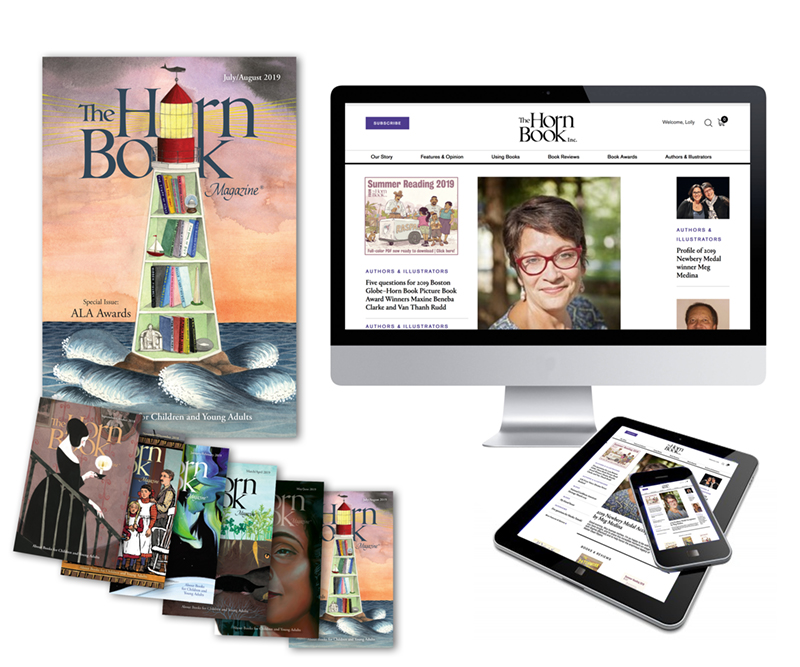
Welcome to the Horn Book's Family Reading blog, a place devoted to offering children's book recommendations and advice about the whats and whens and whos and hows of sharing books in the home. Find us on Twitter @HornBook and on Facebook at Facebook.com/TheHornBook
Summer Reading 2019: Five Questions for Isabel Quintero and Zeke Peña
 Author Isabel Quintero and illustrator Zeke Peña previously collaborated on 2018 Boston Globe–Horn Book Nonfiction Award–winning graphic novel Photographic: The Life of Graciela Iturbide (Getty, 12 years and up). Now, in the summer-perfect picture book My Papi Has a Motorcycle (Kokila/Penguin, 5–8 years; concurrently published in Spanish as Mi papi tiene una moto), they go for a spin around Isabel's hometown of Corona, California. On their route along Grand Boulevard, protagonist Daisy Ramona and her papi cruise by Abuelito and Abuelita's casa, greet friends and neighbors, and stop for refreshing raspados. Daisy reflects on Corona's history, the loving community surrounding her in the present, and their place in her future: "No matter how far I go from this place, or how much it changes, this city will always be with me."
Author Isabel Quintero and illustrator Zeke Peña previously collaborated on 2018 Boston Globe–Horn Book Nonfiction Award–winning graphic novel Photographic: The Life of Graciela Iturbide (Getty, 12 years and up). Now, in the summer-perfect picture book My Papi Has a Motorcycle (Kokila/Penguin, 5–8 years; concurrently published in Spanish as Mi papi tiene una moto), they go for a spin around Isabel's hometown of Corona, California. On their route along Grand Boulevard, protagonist Daisy Ramona and her papi cruise by Abuelito and Abuelita's casa, greet friends and neighbors, and stop for refreshing raspados. Daisy reflects on Corona's history, the loving community surrounding her in the present, and their place in her future: "No matter how far I go from this place, or how much it changes, this city will always be with me."1. How is collaborating on a picture book the same as/different from collaborating on graphic nonfiction?
Isabel Quintero: My Papi Has a Motorcycle was different because I already had a completed manuscript written by the time Zeke saw it. With Photographic, I was writing it as Zeke was illustrating. I was also writing in a lot of description and directions for Zeke; not so much with the picture book. But it was similar in that we kept in constant communication throughout the process.
 Zeke Peña: We had a lot more room to include some fun fictional elements while trying to stay as true as possible to Isabel's memories. I think the process was more exciting because of that freedom. With graphic nonfiction you always have to return back to the historical narrative and context.
Zeke Peña: We had a lot more room to include some fun fictional elements while trying to stay as true as possible to Isabel's memories. I think the process was more exciting because of that freedom. With graphic nonfiction you always have to return back to the historical narrative and context.2. Isabel, you say in the author's note that "History and change are always on my mind." How would you characterize the change(s) that have transpired in Corona?
IQ: I can't speak for the whole city, but one of the major changes is that it went from being focused on agriculture, most notably citrus, to a more suburban feel, especially outside the circle of Grand Boulevard. Within the circle the city is very Latinx and working class, but that begins to shift the farther out you go. Businesses — the tortilleria, raspado shop, movie theaters — and even some of the people who were physically present when I was a kid only exist in my memory — and now in the book! For many, these changes represent progress, but whose vision of progress is it? Are shopping centers that all look the same, city after city, in the Inland Empire really progress? Do they reflect each city's different personality or add to the diversity in our region? Instead, it feels like a push toward homogeneity in which a tortilleria or raspado shop seems foreign or out of place. I haven't lived in Corona for a few years, and I love the city, but it does make me sad when I see less and less of what I grew up around.
3. Zeke, did your pictures come from looking at photos or primarily Isabel's descriptions?
ZP: Both. Isabel sent me photos from her childhood and some of what Corona looks like today. I also did some research about the agricultural industry and racetrack in Corona. We decided to focus on the emotional connection that the protagonist, Daisy Ramona, has to the places in her neighborhood. When we are younger we remember things in unique and sometimes exaggerated ways. This helped me capture some of the vivid descriptions Isabel wrote in the text by making some of them larger-than-life, like an enormous raspado.
 4. When was the last time you were on a motorcycle?
4. When was the last time you were on a motorcycle?IQ: I must have been in my mid-20s. I wanted to buy a Vespa but didn't end up getting it because I was too scared to turn. Before that, probably when I was around nineteen, and it was a dirt bike with my dad.
5. What are your favorite raspado flavors?
IQ: Strawberry and maybe pineapple. The fresh fruit kind, with real fruit, where the syrup is made from scratch.
ZP: My favorite raspado flavor is limon.
From the May 2019 issue of Notes from the Horn Book: Summer Reading. For past years’ summer reading lists from The Horn Book, click on the tag summer reading.






Add Comment :-
Be the first reader to comment.
Comment Policy:
Comment should not be empty !!!